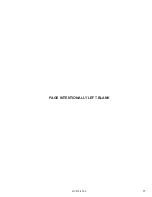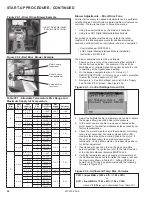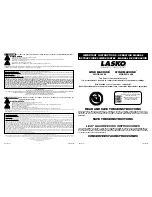
18
MCP15-500.9
1. Turn off power to the unit at the disconnect switch. If
equipped with gas heating option, turn all hand gas valves
to the “OFF” position.
Note:
The dead front disconnect switch, if included, is
factory installed in the controls/compressor compartment
section (refer to the figures on pages 36 through 39). The
disconnect switch is designed so that it must be turned
“OFF” before entry to the compartment can be obtained.
When in the “OFF” position, power is disconnected to all
unit wiring electrically following the switch (see
WARNING).
2. For units equipped for dual power supply sources, both
sources of power must be disconnected to prevent
electrical shock and equipment damage.
3. Open the power compartment, controls compartment, and
blower access doors.
4. Check that the supply voltage matches the unit supply
voltage listed on the Unit Serial Plate. For units equipped
for dual power supply sources, the voltage on both the
main feed and the auxiliary feed must match the unit
supply voltage listed on the Unit Serial Plate.
START-UP PROCEDURE
IMPORTANT
WARNING
WARNING
1. When the dead front disconnect switch(es) (for main
unit and/or powered convenience outlet option) is in the
“OFF” position, supply power remains energized at the
line (supply) side of the dead front disconnect switch(es).
The switch body is located inside of another junction
box to protect against contact with the live wiring.
The junction box must not be disassembled unless
the main power supply from the building to the unit is
de-energized.
2. For units equipped for dual power supply sources, both
sources of power must be disconnected to prevent
electrical shock and equipment damage.
1. To prevent premature heat exchanger failure, check to
be sure the blower has been set to deliver the proper
airflow for the application. Refer to page 19 for Blower
Adjustments.
2. Start-up and adjustment procedures must be performed
by a qualified service agency.
3. All scroll compressors requires the correct supply
power phase rotation. Phase reversal may result in
compressor failure not covered under warranty.
4. The exhaust fan is not designed for high temperature
or smoke control exhaust applications. Exhaust air
temperature must not exceed 104°F. Operating the
exhaust fan above 104°F will result in failure of the
exhaust fan.
5. Check that fuses or circuit breakers are in place and sized
correctly.
6. Verify that all wiring is secure and properly protected. Trace
circuits to ensure that the unit has been wired according to
the wiring diagram.
7. Check that all electrical and gas connections are
weatherized.
8. For C-Cabinet sized units, if the unit is installed with a
Modine supplied Energy Recovery Module, Model ERM,
verify the wiring connection between the MPR unit and the
ERM unit has been properly installed. If the unit is a B or
D-Cabinet sized unit with integral Energy Recovery, the unit
is already factory wired to the Energy Recovery section.
9. For units with gas heating, check to ensure that the
combustion air inlet louvers and the power exhauster
discharge cover (Non-Condensing as determined from
Table 12.1 on page 12) or the vent elbow terminations
(Condensing as determined from Table 12.1 on page 12)
are free from obstructions.
10. For units with condensing gas heating, check that the
condensate drain system is properly installed and the trap
has has been primed with water.
11. For units with Hot Water Heat (Digit 17=4), check the
following:
• Open air vents so that air is eliminated from within the coil
circuitry and headers. Verify that vents and drains are not
obstructed and do discharge a stream of water.
• Open all required valves to fill the coil. Once the coil is
full, close all air vents.
• Perform an initial hydrostatic leak test of all brazed,
threaded or flanged joints, valves and interconnecting
piping, and the hot water coil. Recheck the coil level and
correct if necessary.
• When the setup is found to be leak free, flush the coil
through the drain valve to eliminate grease, oil, flux and
sealing compounds present from the installation.
• Recheck the coil and all connections for water leaks.
• Check water flow rates and pressure drops and compare
to design.
• Check that the hot water supplied to the coil does not
exceed 180°F temperature or 75 PSIG pressure. Verify
that the appropriate glycol mixture is used for freeze
protection.
12. Check to see that there are no obstructions to the intake
and discharge of the unit.
13. Verify that the belts are aligned in the sheave grooves
properly and are not angled from sheave to sheave.
14. On belt driven blowers, blower bearings are permanently
lubricated unless they are pillow block bearings or if they
have grease fittings. For motors or blower bearings that are
not permanently lubricated, lubricate according to the
manufacturer’s instructions. Refer to the Maintenance
section on page 54.
15. Check to make sure that all filters are in place and that
they are installed properly according to direction of air flow.
Pleat direction must be vertical to ensure optimum
performance.
16. Perform a visual inspection of the unit to make sure no
damage has occurred during installation.
General
When servicing the unit, some components may be hot
enough to cause pain or injury. Allow time for cooling of hot
components before servicing.
CAUTION
Содержание MPR Series
Страница 17: ...17 MCP15 500 9 PAGE INTENTIONALLY LEFT BLANK ...
Страница 67: ...67 MCP15 500 9 PAGE INTENTIONALLY LEFT BLANK ...
















































